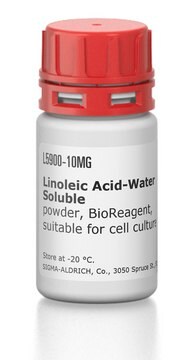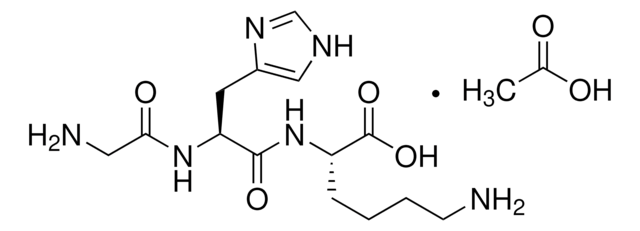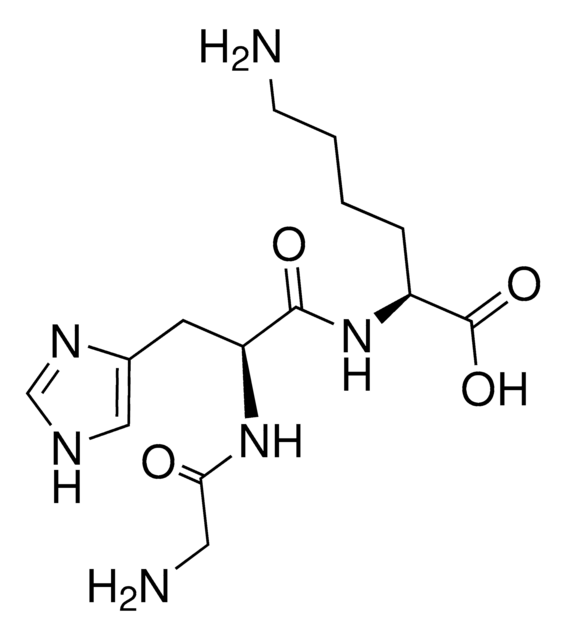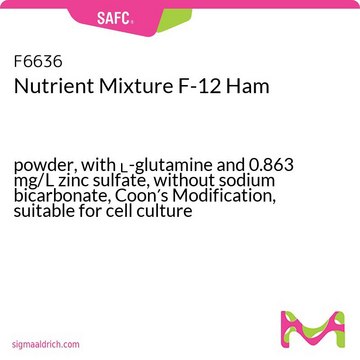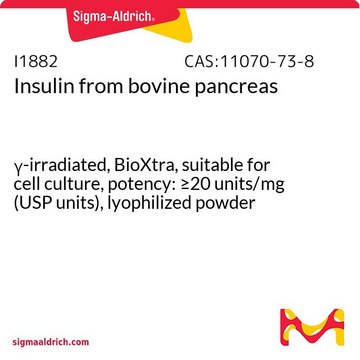G7387
Gly-His-Lys acetate salt
BioXtra, γ-irradiated, suitable for cell culture
Sinonimo/i:
Liver cell growth factor
About This Item
Prodotti consigliati
Origine biologica
synthetic (organic)
Livello qualitativo
Sterilità
γ-irradiated
Nome Commerciale
BioXtra
Stato
powder
PM
400.43 g/mol
Confezionamento
pkg of 5 mg
tecniche
cell culture | mammalian: suitable
Impurezze
<2 EU/mL
Colore
white
Solubilità
H2O: soluble 0.5 mg/mL, clear, colorless
Temperatura di conservazione
−20°C
Stringa SMILE
CC(O)=O.NCCCC[C@H](NC(=O)[C@H](Cc1c[nH]cn1)NC(=O)CN)C(O)=O
InChI
1S/C14H24N6O4.C2H4O2/c15-4-2-1-3-10(14(23)24)20-13(22)11(19-12(21)6-16)5-9-7-17-8-18-9;1-2(3)4/h7-8,10-11H,1-6,15-16H2,(H,17,18)(H,19,21)(H,20,22)(H,23,24);1H3,(H,3,4)/t10-,11-;/m0./s1
MGNUTAFMLGJBGV-ACMTZBLWSA-N
Cerchi prodotti simili? Visita Guida al confronto tra prodotti
Amino Acid Sequence
Applicazioni
- as a component of the serum-containing medium to culture human thyroid cells
- as a supplement to culture fisher rat thyroid cells
- as a component of the Dulbecco′s modified Eagle Medium (DMEM)/HamF12/mesenchymal stem cell media to culture mesenchymal stem cells
Codice della classe di stoccaggio
11 - Combustible Solids
Classe di pericolosità dell'acqua (WGK)
WGK 3
Punto d’infiammabilità (°F)
Not applicable
Punto d’infiammabilità (°C)
Not applicable
Scegli una delle versioni più recenti:
Certificati d'analisi (COA)
Non trovi la versione di tuo interesse?
Se hai bisogno di una versione specifica, puoi cercare il certificato tramite il numero di lotto.
Possiedi già questo prodotto?
I documenti relativi ai prodotti acquistati recentemente sono disponibili nell’Archivio dei documenti.
I clienti hanno visto anche
Il team dei nostri ricercatori vanta grande esperienza in tutte le aree della ricerca quali Life Science, scienza dei materiali, sintesi chimica, cromatografia, discipline analitiche, ecc..
Contatta l'Assistenza Tecnica.

